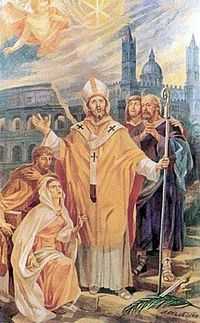Mamilian of Palermo
| Saint Mamilian of Palermo | |
|---|---|
 Painting of Mamilian and his companions. Cathedral of Palermo. | |
| Bishop | |
| Born | Palermo |
| Died |
October 19, 460 Isola di Giglio |
| Honored in | Roman Catholic Church |
| Feast | September 15; June 16 (diocese of Palermo)[1] |
| Attributes | episcopal attire |
| Patronage | Diocese of Pitigliano-Sovana-Orbetello; Isola del Giglio |
Saint Mamilian (Mamilianus) of Palermo, who is venerated with Nympha (Ninfa), Eustotius (Eustozio), Proculus (Proculo, Procuro), and Golbodeus (Golbodeo, Golbudeo), was a bishop of Palermo of the fifth century.[1] Mamilian lived in Sicily at a time when the Vandals dominated the island.[1] He served as bishop of Palermo but was exiled to Africa by the Vandals, who adhered to Arianism, around 450 AD with some Christian companions.[1] One source states that Mamilian was exiled to Tuscany by Genseric, the Vandal king.[2]
However, through the intercession of an African bishop or by some sympathetic Christians, he escaped to Sardinia.[1] After that, he spent time on the island of Montecristo. According to a legend on Montecristo, Mamilian defeated a dragon on the island, and also changed the island’s name from Montegiove ("Jove's Mountain") to Montecristo ("Christ's Mountain").[3] A community of hermits, said to have been Mamilian’s followers, lived on the island, and around 600 AD, a monastery was built.[3]
He subsequently went also to the island of Giglio, where he died.[1]
Golbodeus’s name may a be a corruption of Quodvultdeus, a name shared by another 5th-century saint.[4]
Veneration
According to a tradition on Giglio, inhabitants of Elba and Genoa attempted to steal Mamilian’s relics on the very day of his burial[5] and the saint’s body was torn to pieces. The island of Giglio kept the saint’s arm.[5]
Some sources say Mamilian's relics were translated to Rome, to the Church of Santa Maria in Monticelli, and subsequently to Spoleto.[1] Some of his relics may have been taken to Palermo.[2] Another tradition states that Cosimo III de' Medici, Grand Duke of Tuscany returned Mamilian’s entire body to Giglio in the 17th century.[5]
On the island of Giglio, celebrations dedicated to Saint Mamilian start on September 15 and last for four days, consisting of a process of his relics (Mamilian’s arm), games, music, and a traditional mass.[5]
In 1673, Archbishop Juan Lozano of Palermo erected statues to Mamilian, Eustotius, Proculus, and Golbodeus in the cathedral of Palermo.[6] The statues were made by Travaglia (Mamilian, Golbodeus) and Antonio Anello (Eustotius, Proculus).[6]
-

Grotto of Saint Mamilian. Island of Montecristo.
-

Monastery of San Mamiliano, Island of Montecristo.
References
- ↑ 1.0 1.1 1.2 1.3 1.4 1.5 1.6 Antonino Cottone (2003). "San Mamiliano di Palermo". Santi e beati. Retrieved January 15, 2012.
- ↑ 2.0 2.1 "St. Patrick Catholic Church: Saint of the Day". St. Patrick Catholic Church. Retrieved January 15, 2012.
- ↑ 3.0 3.1 "Montecristo Island". Toscana Viva. Retrieved January 15, 2012.
- ↑ Recueil des notices et mémoires de la Société archéologique du département de Constantine, Volumes 26-27. Société archéologique du département de Constantine (L. Arnolet, 1892), 17.
- ↑ 5.0 5.1 5.2 5.3 "San Mamiliano". Isola del Giglio. Retrieved January 17, 2012.
- ↑ 6.0 6.1 George Dennis, John Murray, A handbook for travellers in Sicily: including Palermo, Messina, Catania, Syracuse, Etna, and the ruins of the Greek temples (J. Murray, 1864), 25.
Bibliography
- Michele Marinelli, San Mamiliano Monaco Vescovo di Palermo, Grosseto 2000
- Ugo Russo, San Mamiliano Vescovo e Martire del V secolo, evangelizzatore della Toscana, supporto CD, Palermo, 2002
- Gloria Peria e Silvestre Ferruzzi, L'isola d'Elba e il culto di San Mamiliano, Portoferraio 2010